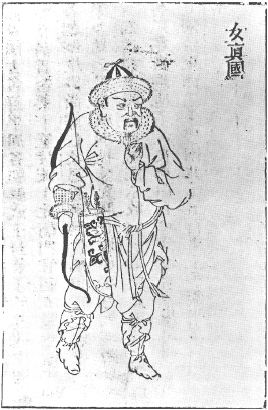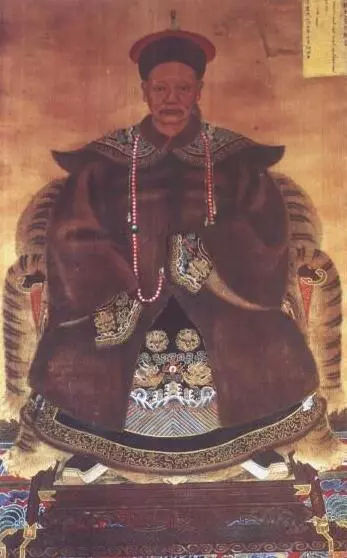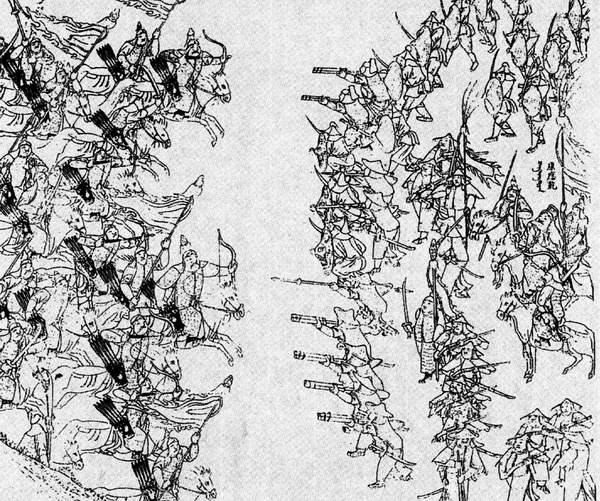|
Dorgon
Dorgon (17 November 1612 – 31 December 1650) was a Manchu prince and regent of the early Qing dynasty. Born in the House of Aisin-Gioro as the 14th son of Nurhaci (the founder of the Later Jin dynasty, which was the predecessor of the Qing), Dorgon started his career in military campaigns against the Mongols, the Koreans, and the Ming dynasty during the reign of Hong Taiji (his eighth brother) who succeeded their father. After Hong Taiji's death in 1643, he was involved in a power struggle against Hong Taiji's eldest son, Hooge, over the succession to the throne. Both of them eventually came to a compromise by backing out and letting Hong Taiji's ninth son, Fulin, become the emperor; Fulin was installed on the throne as the Shunzhi Emperor. Dorgon served as Prince-Regent from 1643 to 1650, throughout the Shunzhi Emperor's early reign. In 1645, he was given the honorary title "Emperor's Uncle and Prince-Regent" (皇叔父攝政王); the title was changed to "Emperor's ... [...More Info...] [...Related Items...] OR: [Wikipedia] [Google] [Baidu] |
Shunzhi Emperor
The Shunzhi Emperor (15 March 1638 – 5 February 1661), also known by his temple name Emperor Shizu of Qing, personal name Fulin, was the second Emperor of China, emperor of the Qing dynasty, and the first Qing emperor to rule over China proper. Upon the death of his father Hong Taiji, a Deliberative Council of Princes and Ministers, committee of Manchu princes chose the 5-year-old Fulin as successor. The princes also appointed two co-regents: Dorgon, the 14th son of Nurhaci, and Jirgalang, one of Nurhaci's nephews, both of whom were members of the Qing imperial clan. In November 1644, the Shunzhi Emperor was enthroned as emperor of China in Beijing. From 1643 to 1650, political power lay mostly in the hands of the prince regent Dorgon. Under his leadership, the Qing conquered most of the territory of the fallen Ming dynasty, chased Southern Ming, Ming loyalist regimes deep into the southwestern provinces, and established the basis of Qing rule over China proper despite highl ... [...More Info...] [...Related Items...] OR: [Wikipedia] [Google] [Baidu] |
Qing Empire
The Qing dynasty ( ), officially the Great Qing, was a Manchu-led Dynasties of China, imperial dynasty of China and an early modern empire in East Asia. The last imperial dynasty in Chinese history, the Qing dynasty was preceded by the Ming dynasty and succeeded by the Republic of China (1912–1949), Republic of China. At its height of power, the empire stretched from the Sea of Japan in the east to the Pamir Mountains in the west, and from the Mongolian Plateau in the north to the South China Sea in the south. Originally emerging from the Later Jin (1616–1636), Later Jin dynasty founded in 1616 and proclaimed in Shenyang in 1636, the dynasty seized control of the Ming capital Beijing and North China in 1644, traditionally considered the start of the dynasty's rule. The dynasty lasted until the Xinhai Revolution of October 1911 led to the abdication of the last emperor in February 1912. The multi-ethnic Qing dynasty Legacy of the Qing dynasty, assembled the territoria ... [...More Info...] [...Related Items...] OR: [Wikipedia] [Google] [Baidu] |
Jirgalang
Jirgalang or Jirhalang (Manchu: ; 19 November 1599 – June 11, 1655) was a Manchu noble, regent, and political and military leader of the early Qing dynasty. Born in the Aisin Gioro clan, he was the sixth son of Šurhaci, a younger brother of Nurhaci, the founder of the Qing dynasty. From 1638 to 1643, he took part in many military campaigns that helped destroy the Ming dynasty. After the death of Huangtaiji (Nurhaci's successor) in September 1643, Jirgalang became one of the young Shunzhi Emperor's two co-regents, but he soon yielded most political power to co-regent Dorgon in October 1644. Dorgon eventually purged him of his regent title in 1647. After Dorgon died in 1650, Jirgalang led an effort to clean the government of Dorgon's supporters. Jirgalang was one of ten " princes of the first rank" (和碩親王) whose descendants were made "iron-cap" princes (鐵帽子王), who had the right to transmit their princely titles to their direct male descendants perpetually. Ca ... [...More Info...] [...Related Items...] OR: [Wikipedia] [Google] [Baidu] |
Queue (hairstyle)
A queue or cue is a hairstyle historically worn by the Jurchen people, Jurchen and Manchu people, Manchu peoples of Manchuria, and was later required to be worn by male subjects of Qing dynasty, Qing China. The top of the scalp is shaved and the back portion of hair on the head is often grown long and is Braid (hairstyle), braided. The distinctive hairstyle led to its wearers being targeted during anti-Chinese sentiment, anti-Chinese riots in History of Chinese Australians, Australia and the History of Chinese Americans, United States. The edict that Han Chinese men and others under Manchu rule give up their traditional hairstyles and wear the queue, the ''Tifayifu'', was met with resistance, although opinions about the queue did change over time. Han women were never required to wear their hair in the traditional women's Manchu style, liangbatou, although that too was a symbol of Manchu identity. Predecessors and origin The queue hairstyle predates the Manchus. The Chinese w ... [...More Info...] [...Related Items...] OR: [Wikipedia] [Google] [Baidu] |
Hong Taiji
Hong Taiji (28 November 1592 – 21 September 1643), also rendered as Huang Taiji and sometimes referred to as Abahai in Western literature, also known by his temple name as the Emperor Taizong of Qing, was the second khan of the Later Jin dynasty and the founding emperor of the Qing dynasty. He was responsible for consolidating the empire that his father Nurhaci had founded and laid the groundwork for the conquest of the Ming dynasty, although he died before this was accomplished. He was also responsible for changing the name of the Jurchens to "Manchu" in 1635, and changing the name of his dynasty from "Great Jin" to "Great Qing" in 1636. Names and titles It is unclear whether "Hong Taiji" was a title or a personal name. Written ''Hong taiji'' in Manchu, it was borrowed from the Mongolian title '' Khong Tayiji''. That Mongolian term was itself derived from the Chinese ''huang taizi'' 皇太子 ("crown prince", "imperial prince"), but in Mongolian it meant, among other ... [...More Info...] [...Related Items...] OR: [Wikipedia] [Google] [Baidu] |
Princess Uisun
Princess Uisun (1635–1662; birth name Yi Ae-suk) was a Joseon Royal Family member who became the adopted daughter of Hyojong of Joseon and Queen Inseon, so she could marry the Aisin Gioro prince Dorgon and later, prince Bolo. Biography Background Yi Ae-suk was born one of the four daughters and seven sons of Yi Gye-yun, himself a 4th great-grandson of Seongjong of Joseon, and a fourth cousin twice removed of Hyojong. Political marriage In 1650, Dorgon sent the minister of Ministry of Revenue, Gioro Bahana, as an emissary to the Joseon court, to forge an alliance with Hyojong of Joseon, asking the king to choose a suitable bride for him. The bride could be a daughter of either a royal family member or a subject.Veritable Records of Hyojong, day 7, month 3, year 1 of Hyojong's rei ... [...More Info...] [...Related Items...] OR: [Wikipedia] [Google] [Baidu] |
Hooge, Prince Su
Hooge (Manchu: ; 16 April 1609 – 4 May 1648), formally known as Prince Su, was a Manchu prince of the Qing dynasty. He was the eldest son of Hong Taiji, the second ruler of the Qing dynasty. Life Hooge was born in the Aisin Gioro clan as the eldest son of Hong Taiji, the second ruler of the Qing dynasty. His mother was Lady Ula Nara, one of Hong Taiji's consorts. Hooge participated in military campaigns against the Mongols, Koreans and the Ming dynasty. After Hong Taiji's death in 1643, Hooge and his uncle Dorgon fought over the succession to the throne. The situation was to Hooge's advantage because three of the Eight Banners previously under Hong Taiji's control had been passed on to him. On the other hand, Dorgon had the support of his brothers and two White Banners. This meant that the remaining two Red Banners controlled by Daišan and his son, as well as the Bordered Blue Banner under Chiurhala, were crucial to ensuring that Hooge could win the succession. After much d ... [...More Info...] [...Related Items...] OR: [Wikipedia] [Google] [Baidu] |
Prince Rui (睿)
Prince Rui of the First Rank, or simply Prince Rui, was the title of a princely peerage used in China during the Manchu-led Qing dynasty (1644–1912). It was also one of the 12 "iron-cap" princely peerages in the Qing dynasty, which meant that the title could be passed down without being downgraded. The first bearer of the title was Dorgon (1612–1650), the 14th son of Nurhaci, the founder of the Later Jin dynasty. He was awarded the title in 1636 by his half-brother, Hong Taiji, who succeeded their father to the Later Jin throne and who later established the Qing dynasty. After Dorgon's death, the Shunzhi Emperor abolished the Prince Rui peerage. In 1778, the Qianlong Emperor not only restored the Prince Rui peerage, but also granted it "iron-cap" status. Chunying (died 1800), a sixth-generation descendant of Dorgon's younger brother, Dodo, was selected to inherit the Prince Rui title. The title was passed down over 12 generations and held by eight persons. Members of the P ... [...More Info...] [...Related Items...] OR: [Wikipedia] [Google] [Baidu] |
Nurhaci
Nurhaci (14 May 1559 – 30 September 1626), also known by his temple name as the Emperor Taizu of Qing, was the founding khan of the Jurchen people, Jurchen-led Later Jin (1616–1636), Later Jin dynasty. As the leader of the House of Aisin-Gioro, Nurhaci reorganized and united various Jurchen tribes (the later "Manchu people, Manchu"), consolidated the Eight Banners military system, and eventually launched attacks on both the Ming dynasty, Ming and Joseon dynasties. His conquest of Ming dynasty's northeastern Liaodong region laid the groundwork for the Qing conquest of the Ming by his descendants, who proclaimed the Qing dynasty in 1636. He is also generally credited with ordering the creation of a new written script for the Manchu language based on the Mongolian script, Mongolian vertical script. Name and titles Nurhaci is written as in Manchu language. Some suggest that the meaning of the name in the Manchu language is "the skin of a wild boar". Another explanation is "brav ... [...More Info...] [...Related Items...] OR: [Wikipedia] [Google] [Baidu] |
Dodo, Prince Yu
Dodo ( mnc, ᡩᠣᡩᠣ, z=Dodo; 2 April 1614 – 29 April 1649), formally known as Prince Yu, was a Manchu prince and military general of the early Qing dynasty. Family background Dodo was born in the Manchu Aisin Gioro clan as the 15th son of Nurhaci, the founder of the Later Jin dynasty. His mother was Nurhaci's primary spouse Lady Abahai, who also bore Dodo's full brothers Ajige and Dorgon. Career Hong Taiji's reign In 1620, Dodo was conferred the title of an ''ejen''. He became a ''beile'' at the age of 13 and was put in charge of the Plain White Banner, and started administrating affairs in the Ministry of Rites and Ministry of War. In 1628, Dodo followed Hong Taiji on the conquest of Chahar, Mongolia, and was granted the title of ''eerkechuhuer'' (額爾克楚虎爾) for his achievements. The following year, he followed Hong Taiji again on the conquest of the Ming dynasty, crossing the Great Wall and closing in on the Ming capital Beijing. In 1631, Dodo wa ... [...More Info...] [...Related Items...] OR: [Wikipedia] [Google] [Baidu] |
Empress Dowager Xiaozhuang
Bumbutai (; mnc, m= ; zh, 布木布泰; 28 March 1613 – 27 January 1688), of the Khorchin Mongol Borjigit clan, was the consort of Hong Taiji. She was 21 years his junior. She was honoured as Empress Dowager Zhaosheng during the reign of her son, Fulin, the Shunzhi Emperor, and as Grand Empress Dowager Zhaosheng during the reign of her grandson, Xuanye, the Kangxi Emperor. As empress dowager and grand empress dowager, she had significant influence in the Qing imperial court and was highly respected for her political wisdom and insight. After her death, she was posthumously honoured with the title Empress Xiaozhuangwen, although she never held the rank of empress consort during her lifetime. Life Family background * Father: Zhaisang (), held the title of a first rank prince () ** Paternal grandfather: Manggusi (), held the title of a first rank prince () ** Paternal aunt: Empress Xiaoduanwen (1599–1649) * Mother: Boli (; d. 1654) * Four elder brothers * One elder si ... [...More Info...] [...Related Items...] OR: [Wikipedia] [Google] [Baidu] |







